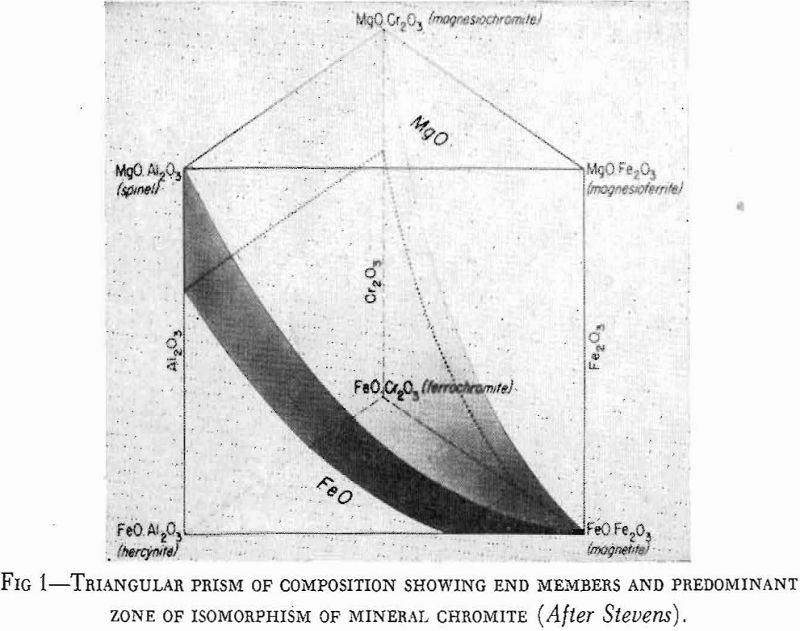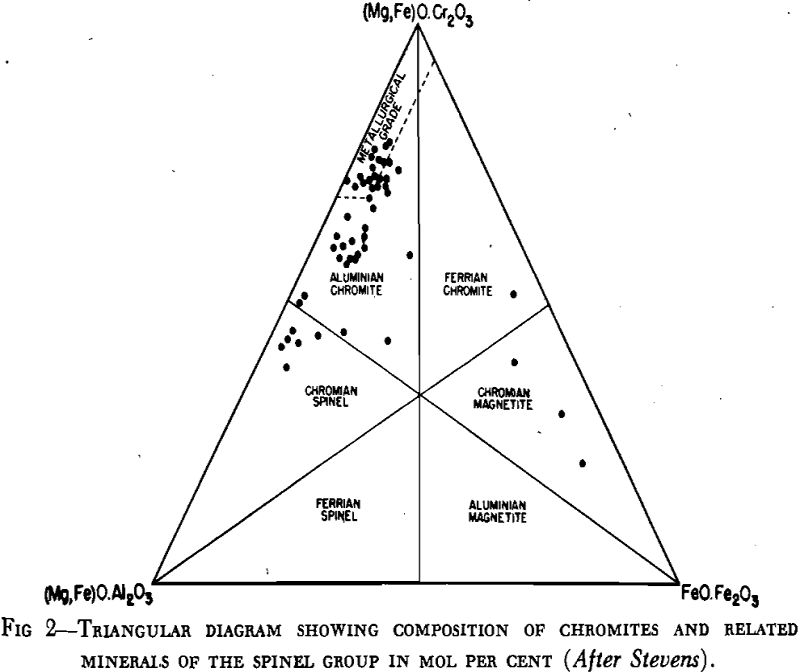Table of Contents
The minerals that collectively are known as chromite form an isomorphous series of the general formula (Mg,Fe)O. (Cr,Al,Fe)2O3. So wide is the range in chemical composition in this group that chrome ore consisting entirely of the mineral chromite may range from less than 30 pct to more than 60 pct Cr2O3.
The most comprehensive published data on the chemical composition of chromite are by Stevens, who made complete analyses of 52 samples of chromite concentrate from many localities in North, Cen-

tral, and South America. These samples were mechanically purified to remove associated silicates and might be regarded as the cleanest chromite that could be obtained by any mechanical milling process.

Properties
Chromite crystallizes in the isometric system, in octahedrons. Commonly it is massive or fine granular to compact. The fracture is uneven. It is brittle. Its hardness is about 5.5. Its specific gravity ranges from 4.1 to 4.9. Its luster is submetallic to metallic. It is iron black to brownish black and has a brown streak. In thin section it is translucent to opaque; the high-chrome varieties are red-brown and the high-alumina varieties more coffee brown. Some chromites are feebly magnetic.
Types of Geological Occurrence
Chromite is found in ultrabasic rocks or serpentines that have been derived from them. The crystallization of chromite is essentially contemporaneous with the enclosing ultrabasic rocks but some variation in the composition of the chromite itself may result from deuteric reaction with the silicate minerals of the host rock.
Thayer finds a correlation between the composition of the chromite and the associated rocks. He says: “High-alumina chromites occur in peridotitic masses which contain feldspathic members, and high-chrome chromites occur in feldspar-free peridotites low in alumina and iron. The high-iron chromites of the Bushveld type apparently resulted from crystallization in pyroxenic environments deficient in alumina and relatively rich in iron.”
Distribution of Deposits
Chromite deposits occur in California, Oregon, and Washington as sackform bodies in ultrabasic rocks or in serpentine derived from them. Most deposits are small and exploration and discovery costs are high. Much of the chromite is of metallurgical grade. Characteristic deposits are described in references given in the bibliography at the end of the chapter.
The principal chromite-producing countries of the world are Cuba, Greece, Turkey, Yugoslavia, USSR, Southern Rhodesia, Union of South Africa, India, New Caledonia, and the Philippines. Countries with smaller productions in recent years are Canada, Guatemala, Brazil, Albania, Bulgaria, Cyprus, Iran, Japan, Sierra Leone, and Australia.
Prospecting and Exploration
The “sackform” type of deposit, which occurs in apparent random distribution through ultrabasic igneous rocks, is generally found by tracing chromite float to the outcrop. Recent detailed geological work on deposits of this type in California and Oregon has indicated that dunite or serpentine derived from dunite is a more favorable environment than the less basic feldspar-bearing rocks. The gravimeter was used with marked success in the Camaguey district, Cuba, in locating sackform bodies that did not outcrop. Previous geological mapping had restricted the area for gravimeter exploration to the most favorable host rock and topographic conditions were unusually favorable.
Grades and Specifications
Refractory ores are high in Cr2O3 plus Al2O3 and relatively low in Fe and SiO2. They are used in making chrome brick, chrome-magnesite brick, plastic cement and other refractory products. The principal limiting factor in the refractoriness of chrome brick is the silicate binding rather than the chrome itself, therefore the amount of silica and fluxes such as lime must be kept to a minimum. In industrial practice, an excess of MgO is added to all chrome ores to combine all the silica in forsterite during firing.

